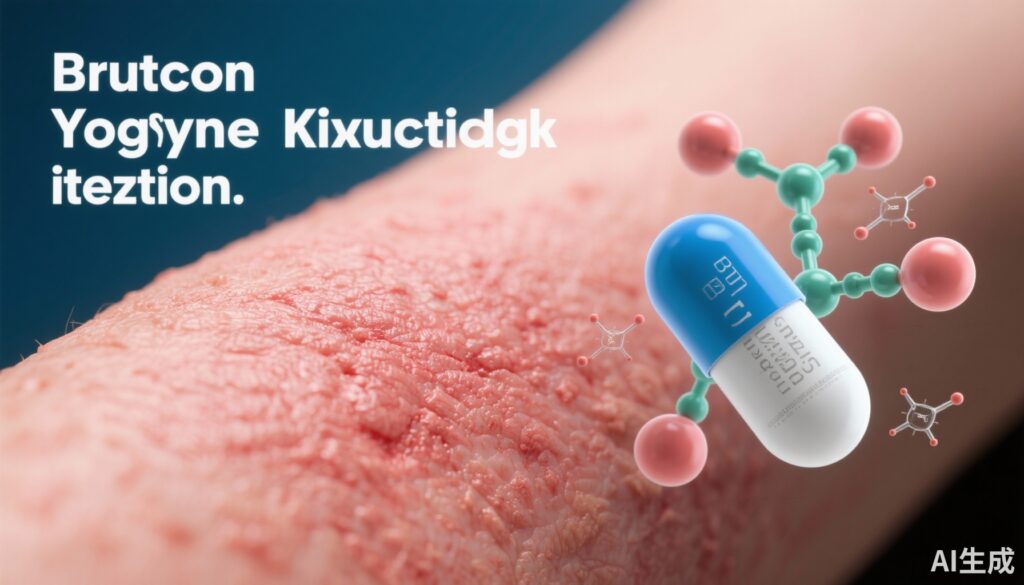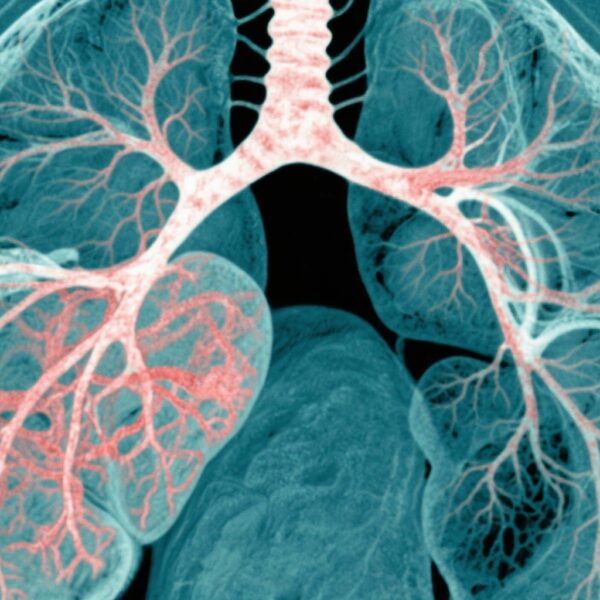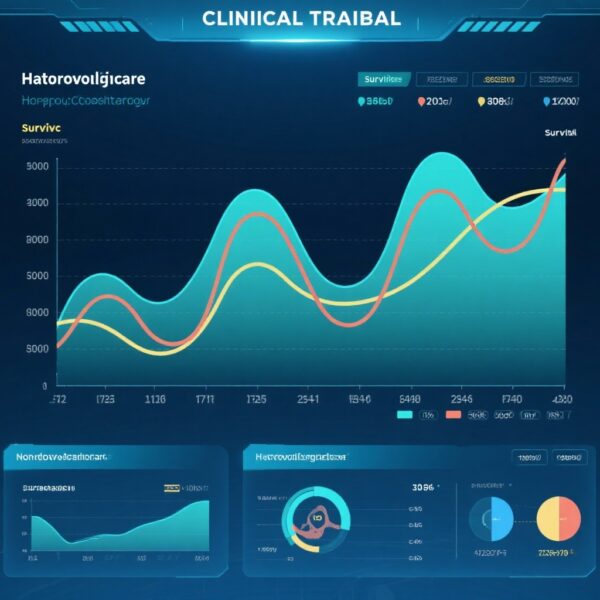Highlight
- The proof-of-concept phase II trial assessed rilzabrutinib, an oral selective BTK inhibitor, for moderate-to-severe atopic dermatitis (AD).
- Rilzabrutinib did not significantly improve the primary efficacy endpoint (EASI score reduction) versus placebo at 16 weeks.
- Rapid and consistent improvement in itch severity (PP-NRS scores) was observed with rilzabrutinib compared to placebo.
- The safety profile of rilzabrutinib was favorable, with mild adverse events and no typical toxicities seen with other BTK inhibitors.
Study Background
Atopic dermatitis (AD) is a chronic inflammatory skin disorder characterized by eczematous lesions, intense itch, and impaired quality of life. It affects millions worldwide, with a substantial disease burden that includes physical discomfort, psychological distress, and socioeconomic costs. Moderate-to-severe AD often requires systemic treatment beyond topical therapies due to inadequate disease control. Existing systemic options include immunosuppressants and biologics, but limitations such as safety concerns, parenteral administration routes, and incomplete responses persist.
AD’s pathophysiology is complex, involving interplay between adaptive and innate immune mechanisms. Bruton tyrosine kinase (BTK), a key enzyme involved in B-cell receptor and Fc receptor signaling, participates in signaling pathways contributing to AD inflammation and itch. Rilzabrutinib is an oral, selective, and reversible covalent BTK inhibitor designed to modulate these pathways with a potentially improved safety profile compared to earlier BTK inhibitors.
Study Design
This randomized, double-blind, placebo-controlled, proof-of-concept phase II trial enrolled adults with moderate-to-severe AD who had inadequate response or intolerance to topical corticosteroids. Participants were assigned sequentially to two dose cohorts: 800 mg daily (administered as 400 mg twice daily) and 1200 mg daily (400 mg three times daily). Within each cohort, patients were randomized 3:2 to receive rilzabrutinib or placebo for 16 weeks.
The primary efficacy endpoint was the percentage change from baseline to week 16 in the Eczema Area and Severity Index (EASI), which quantifies disease severity and extent. Key secondary endpoints included the proportion of participants achieving an Investigator’s Global Assessment (IGA) score of 0 (clear) or 1 (almost clear), the proportion achieving at least 75% improvement in EASI score (EASI 75), and the proportion with a reduction of ≥4 points from baseline in the weekly average daily Peak Pruritus Numerical Rating Scale (PP-NRS), which assesses itch intensity.
Safety outcomes comprised the incidence and severity of treatment-emergent adverse events (TEAEs), with particular attention to known toxicities of BTK inhibitors.
Key Findings
The primary endpoint was not met. The least squares mean difference in percent change of EASI score at week 16 compared to placebo was -6.3% (P=0.62) in the 800 mg group and -3.9% (P=0.67) in the 1200 mg group, indicating no statistically significant improvement in disease severity with rilzabrutinib.
Similarly, key secondary endpoints, including the proportions achieving IGA 0 or 1 and EASI 75, did not differ significantly between rilzabrutinib and placebo arms.
However, a consistent and rapid improvement in itch was observed with rilzabrutinib as measured by the weekly average daily PP-NRS. Patients receiving rilzabrutinib experienced greater reductions in pruritus intensity compared to placebo early during treatment, which persisted through week 16.
Safety profile analysis demonstrated that rilzabrutinib was well tolerated. TEAEs were predominantly mild, with nausea and diarrhoea reported more frequently than with placebo. Importantly, the severe adverse event profile commonly noted with earlier generations of BTK inhibitors, such as bleeding events or cardiac arrhythmias, was absent with rilzabrutinib. This favorable tolerability supports its safety for potential long-term use.
Expert Commentary
These results, published in the British Journal of Dermatology, highlight the intricacies of targeting BTK in moderate-to-severe AD. Despite the failure to achieve statistically significant improvements in clinical eczema severity scores, the rapid and sustained itch relief is clinically meaningful because pruritus is the most burdensome symptom impacting patient quality of life.
The dissociation between itch response and eczema lesion improvement may suggest that rilzabrutinib’s mechanism modulates neuroimmune pathways related to pruritus more effectively than inflammatory skin manifestations at these doses or durations.
Methodologically, the trial’s relatively short duration and sample size may limit detection of differences in EASI or IGA outcomes, which often require longer treatment courses or larger cohorts to manifest significant changes. Additional investigations with extended follow-up, combination regimens, or biomarker-guided dosing might better elucidate rilzabrutinib’s place in AD therapy.
Conclusion
This phase II proof-of-concept trial did not meet the primary efficacy endpoint of improving overall eczema severity in moderate-to-severe atopic dermatitis with rilzabrutinib versus placebo. Nonetheless, the observed rapid and consistent improvement in itch, coupled with an acceptable safety profile that lacks the adverse events typical of earlier BTK inhibitors, supports further exploration of rilzabrutinib as a potential oral treatment option to address the unmet needs of patients with AD.
Future research should focus on optimizing dosing strategies, understanding mechanistic pathways modulated by BTK inhibition in AD, and exploring longer-term efficacy and safety in larger, diverse populations.
Funding and Clinical Trial Registration
The study was funded and conducted by pharmaceutical sponsors involved in rilzabrutinib development. The clinical trial registration number and detailed funding information can be referenced in the original publication:
Kircik L, et al. Br J Dermatol. 2025 Aug 18;193(3):424-433. doi: 10.1093/bjd/ljaf156. PMID: 40317187.
References
- Kircik L, Tsianakas A, Valenzuela F, Mikol V, Nian G, Mannent L, Baret-Cormel L. Efficacy and safety of rilzabrutinib in patients with moderate-to-severe atopic dermatitis: 16-week results from a proof-of-concept phase II clinical trial. Br J Dermatol. 2025 Aug 18;193(3):424-433. doi:10.1093/bjd/ljaf156.
- Silverberg JI. Public health burden and epidemiology of atopic dermatitis. Dermatol Clin. 2017;35(3):283-289.
- Kim BS, Howell MD. Immunopathogenesis of atopic dermatitis and emerging therapies. Curr Allergy Asthma Rep. 2018;18(5):28.
- Hawkes JE, Chan TC, Krueger JG. Psoriasis pathogenesis and the development of novel targeted immune therapies. J Allergy Clin Immunol. 2017;140(3):645-653.



